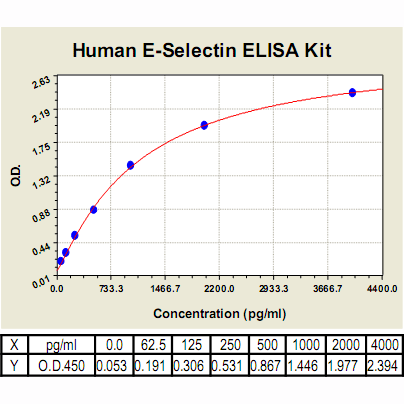Product Sheet CL0501
Description
BACKGROUND The selectin family of adhesion molecules mediates the initial attachment of leukocytes to venular endothelial cells before their firm adhesion and diapedesis at sites of tissue injury and inflammation. The selectin family consists of three closely related cell-surface molecules with differential expression by leukocytes (L-selectin), platelets (P-selectin), and vascular endothelium (E- and P-selectin). The selectins have characteristic extracellular regions composed of an amino-terminal lectin domain that binds a carbohydrate ligand, an epidermal growth factor-like domain, and two to nine short repeat units homologous to domains found in complement binding proteins. In contrast to most other adhesion molecules, selectin function is restricted to leukocyte interactions with vascular endothelium. Multiple studies indicate that the selectins mediate neutrophil, monocyte, and lymphocyte rolling along the venular wall. The generation of selectin-deficient mice has confirmed these findings and provided further insight into how the overlapping functions of these receptors regulate inflammatory processes. Selectin-directed therapeutic agents are now proven to be effective in blocking many of the pathological effects resulting from leukocyte entry into sites of inflammation.1
E-selectin is an endothelial cell-specific membrane glycoprotein that mediates slow rolling and stable arrest of leukocytes on endothelium during inflammation. E-selectin binds two ligands, PSGL-1 and E-selectin ligand-1 (ESL-1).2 Some glycolipids can support E-selectin dependent rolling in vitro. Its function in mediating leukocyte rolling is largely redundant with that of P-selectin. E-selectin operates "downstream" from P-selectin, more toward the firm adhesion step of the cascade. E-selectin is not constitutively expressed in endothelial cells, but is transcriptionally induced by NF-κB and AP-1 in response to inflammatory cytokines such as IL-1beta and TNF-alpha. Consequently, elevated E-selectin expression was reported in many types of inflammatory diseases including diabetes, atherosclerosis, rheumatoid arthritis, and cancer. In addition to E-selectin-mediated inflammation, many studies have suggested a potential involvement of E-selectin in the attachment and transmigration of circulatory metastatic cancer cells through the endothelium.3 In addition, there is evidence that E-selectin may play a role in angiogenesis. It was shown that antibodies directed against E-selectin inhibited the formation of capillary-like tubes in vitro. It was reported that soluble E-selectin, which lacks the transmembrane and cytoplasmic domains, induces angiogenesis in the rat cornea and stimulates chemotaxis and tube formation of human dermal microvascular endothelial cells (HDMEC) through Src- and phosphatidylinositol 3-kinase-mediated pathways. E-selectin is closely associated with essential events of angiogenesis including endothelial cell proliferation, migration, and neovascularization.4
E-selectin is an endothelial cell-specific membrane glycoprotein that mediates slow rolling and stable arrest of leukocytes on endothelium during inflammation. E-selectin binds two ligands, PSGL-1 and E-selectin ligand-1 (ESL-1).2 Some glycolipids can support E-selectin dependent rolling in vitro. Its function in mediating leukocyte rolling is largely redundant with that of P-selectin. E-selectin operates "downstream" from P-selectin, more toward the firm adhesion step of the cascade. E-selectin is not constitutively expressed in endothelial cells, but is transcriptionally induced by NF-κB and AP-1 in response to inflammatory cytokines such as IL-1beta and TNF-alpha. Consequently, elevated E-selectin expression was reported in many types of inflammatory diseases including diabetes, atherosclerosis, rheumatoid arthritis, and cancer. In addition to E-selectin-mediated inflammation, many studies have suggested a potential involvement of E-selectin in the attachment and transmigration of circulatory metastatic cancer cells through the endothelium.3 In addition, there is evidence that E-selectin may play a role in angiogenesis. It was shown that antibodies directed against E-selectin inhibited the formation of capillary-like tubes in vitro. It was reported that soluble E-selectin, which lacks the transmembrane and cytoplasmic domains, induces angiogenesis in the rat cornea and stimulates chemotaxis and tube formation of human dermal microvascular endothelial cells (HDMEC) through Src- and phosphatidylinositol 3-kinase-mediated pathways. E-selectin is closely associated with essential events of angiogenesis including endothelial cell proliferation, migration, and neovascularization.4
REFERENCES
1. Rosen, S.D. et al: Ann. Rev. Immunol. 22:129-56, 2003
2. Varki, A. et al: Proc. Natl. Acad. Sci. USA 91:7390-7, 1994
3. Mann, A.P. et al: PloS ONE 5:e13050, 2010
4. Koch, A. E. et al: Nature 376:517-9, 2002
2. Varki, A. et al: Proc. Natl. Acad. Sci. USA 91:7390-7, 1994
3. Mann, A.P. et al: PloS ONE 5:e13050, 2010
4. Koch, A. E. et al: Nature 376:517-9, 2002
Products are for research use only. They are not intended for human, animal, or diagnostic applications.
Details
Cat.No.: | CL0501 |
Target Protein Species: | Human |
Range: | 62.5 pg/ml – 4000pg/ml |
Specificity: | No detectable cross-reactivity with IGF-1 |
Storage: | Store at 4°C. Use within 6 months. |
ELISA Kits are based on standard sandwich enzyme-linked immunosorbent assay technology. Freshly prepared standards, samples, and solutions are recommended for best results.
Products
| Product | Size | CAT.# | Price | Quantity |
|---|---|---|---|---|
| Human E-Selectin ELISA Kit: Human E-Selectin ELISA Kit | Size: 96 Wells | CAT.#: CL0501 | Price: $587.00 |

